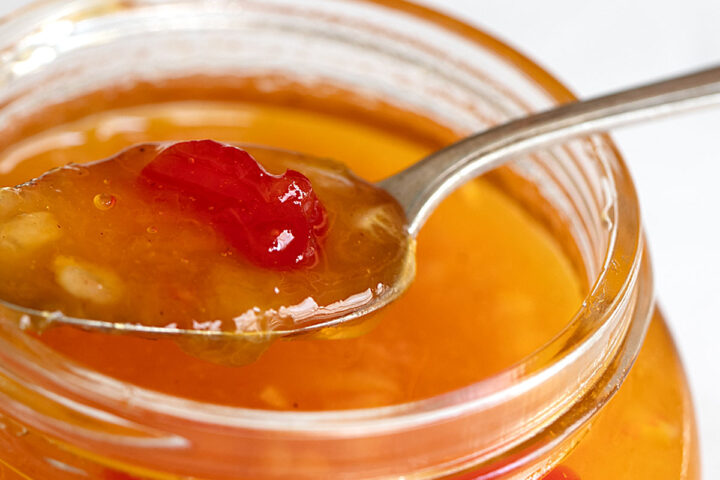
Get the Recipe: Peach Marmalade
A lovely combination of peach jam and orange marmalade flavours, with added maraschino cherries.
Ingredients
- 2 lbs peaches, peeled, pitted and sliced
- 1 medium navel orange
- Juice from 1/2 lemon
- 3- 3 1/2 cups granulated white sugar, approximately *see Note 1
- 1 teaspoon vanilla or vanilla bean paste
- 10 maraschino cherries, halved or quartered
Equipment
- Kitchen scale for weighing fruit and sugar
Instructions
- If you don't have a jam/sugar thermometer, place a small dinner plate into the freezer before starting your marmalade, to use for the Cold Plate Test for done-ness (see Note 2 below).
- Peel, pit and slice the peaches. (I like to use a nice, sharp vegetable peeler to peel peaches). Remove the ends from orange and slice across the equator as thinly as you can. Chop the peel and flesh into smaller pieces. (You can chop as finely or as coarsely as you prefer).
- Cut maraschino cherries in half or quarters and place on a paper towel to absorb the juices. Set aside.
- Place the prepared peach slices and chopped orange into a large bowl. Add the lemon juice. Weigh the fruit mixture. Add an equal weight of granulated sugar to the bowl. (So, in my case, my fruit weighed 774g/27oz) so I weighed out that same amount of sugar by weight and added it to the fruit mixture). Stir to combine.
- Place the fruit/sugar mixture in a large, heavy bottom pan (not aluminum) over medium heat and stir until the sugar dissolves. *I like to use a potato masher to break down the peaches a little bit at this point. Raise heat to medium-high and continue cooking until juices start to thicken and jam tests done on a chilled plate *, about 10-15 minutes. *If you like a chunkier marmalade, you don't need to do anything. For a less chunky marmalade, you can use an immersion blender at the end of cooking (before adding vanilla and cherries), to make a smoother marmalade. Be careful with the immersion blender as the liquid is very hot!
- Remove the pan from heat. Stir in vanilla and cherries. Spoon into clean jar or jars, leaving 1/2-inch headspace. Place lid and ring on just fingertip tight and invert jar on tea towel. Allow to stand (inverted) until cooled to room temperature, then immediately refrigerate. (Inverting hot jam will give you a "soft seal" of the canning lid, but is not considered a sufficient seal for room-temperature storage, so the marmalade MUST be stored in the refrigerator unless you take the extra step of properly sealing by the boiling water bath sealing method.
- *If you wish to can the jam, spoon into sterilized jars and process in a water bath. Always refer to a reputable source of canning information for how to sterilize and how long to process in a boiling water bath.
Notes
- The sugar amount is approximate. You will need to weigh your peach/orange mixture and then add an equal amount (by weight) of white sugar. The general ration of fruit to sugar is 1:1 and it is always best to stick to this ratio for proper setting and prolonged shelf-life. Always remember, jam is a condiment, not a meal :)
- Cold Plate Test: Before you start your jam or marmalade, plate a small dinner plate into the freezer. As your jam comes close to done, remove the plate from the freezer and place a drop of the hot jam liquid on the plate. run your finger through the drop. If the space where you ran your finger through runs back together and fills in the space, your jam is not done yet. Boil a little longer and test again. When the space where your finger run through it remains AND the edges along where you ran your finger appear slightly raised (as opposed to flat and thin) or wrinkled, your jam is ready.
Serving: 1cup, Calories: 1194kcal, Carbohydrates: 306g, Protein: 2g, Fat: 1g, Saturated Fat: 1g, Polyunsaturated Fat: 1g, Monounsaturated Fat: 1g, Sodium: 4mg, Potassium: 499mg, Fiber: 5g, Sugar: 301g, Vitamin A: 831IU, Vitamin C: 36mg, Calcium: 38mg, Iron: 1mg
Tried this recipe?Leaving a review is always appreciated and so helpful for our fellow cooks!